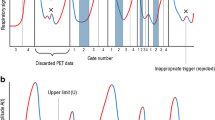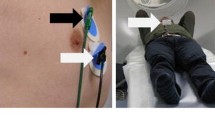Abstract
The fusion of computed tomography (CT) and positron emission tomography (PET) may improve diagnostic accuracy, but is limited by different breathing protocols. This study aimed at quantifying respiration-induced alignment errors. PET-CT was acquired in 24 patients. Contrast-enhanced whole-body CT was obtained in a single breath hold in the expiratory state of a normal breathing cycle. An inspiratory low-dose CT of the thorax was acquired in the same session, and comparison of the two CT scans was used to assess the potential mismatch of PET and CT fusion. The largest craniocaudal expansion was found in the area of the diaphragm. A considerable sagittal expansion was found in the anterior parts of the lungs. Central tracheo-bronchial structures were displaced during inspiration mainly in the anterior and caudal directions. The craniocaudal shift of central structures showed a linear correlation with the diaphragmatic expansion, whereas the sagittal shift correlated with the sagittal pleural expansion. There was, however, no correlation between craniocaudal and sagittal respiratory motion. Alignment errors are most severe in the base of the lung, but central structures are affected, too. Understanding of the main vectors of respiratory motion may help in image interpretation when PET and CT are acquired separately.


Similar content being viewed by others
References
Townsend DW, Cherry SR (2001) Combining anatomy and function: the path to true image fusion. Eur Radiol 11:1968–1974
Townsend DW, Beyer T, Blodgett TM (2003) PET/CT scanners: a hardware approach to image fusion. Semin Nucl Med 33:193–204
Lardinois D, Weder W, Hany TF, Kamel EM, Korom S, Seifert B, von Schulthess GK, Steinert HC (2003) Staging of non-small-cell lung cancer with integrated positron-emission tomography and computed tomography. N Engl J Med 348:2500–2507
Antoch G, Stattaus J, Nemat AT, Marnitz S, Beyer T, Kuehl H, Bockisch A, Debatin JF, Freudenberg LS (2003) Non-small cell lung cancer: dual-modality PET/CT in preoperative staging. Radiology 229:526–533
Beyer T, Antoch G, Blodgett T, Freudenberg LF, Akhurst T, Mueller S (2003) Dual-modality PET/CT imaging: the effect of respiratory motion on combined image quality in clinical oncology. Eur J Nucl Med Mol Imaging 30:588–596
Osman MM, Cohade C, Nakamoto Y, Wahl RL (2003) Respiratory motion artifacts on PET emission images obtained using CT attenuation correction on PET-CT. Eur J Nucl Med Mol Imaging 30:603–606
Goerres GW, Burger C, Kamel E, Seifert B, Kaim AH, Buck A, Buehler TC, Von Schulthess GK (2003) Respiration-induced attenuation artifact at PET/CT: technical considerations. Radiology 226:906–910
Goerres GW, Kamel E, Heidelberg TN, Schwitter MR, Burger C, von Schulthess GK (2002) PET-CT image co-registration in the thorax: influence of respiration. Eur J Nucl Med Mol Imaging 29:351–360
Wade OL (1954) Movements of the thoracic cage and diaphragm in respiration. J Physiol 124:193–212
Davies SC, Hill AL, Holmes RB, Halliwell M, Jackson PC (1994) Ultrasound quantitation of respiratory organ motion in the upper abdomen. Br J Radiol 67:1096–1102
Goerres GW, Burger C, Schwitter MR, Heidelberg TN, Seifert B, von Schulthess GK (2003) PET/CT of the abdomen: optimizing the patient breathing pattern. Eur Radiol 13:734–739
Nakamoto Y, Tatsumi M, Cohade C, Osman M, Marshall LT, Wahl RL (2003) Accuracy of image fusion of normal upper abdominal organs visualized with PET/CT. Eur J Nucl Med Mol Imaging 30:597–602
Osman MM, Cohade C, Nakamoto Y, Marshall LT, Leal JP, Wahl RL (2003) Clinically significant inaccurate localization of lesions with PET/CT: frequency in 300 patients. J Nucl Med 44:240–243
Ollenberger GP (2004) Staging of lung cancer with integrated PET-CT. N Engl J Med 350:86–87
Antoch G, Freudenberg LS, Stattaus J, Jentzen W, Mueller SP, Debatin JF, Bockisch A (2002) Whole-body positron emission tomography-CT: optimized CT using oral and IV contrast materials. AJR Am J Roentgenol 179:1555–1560
Kinahan PE, Townsend DW, Beyer T, Sashin D (1998) Attenuation correction for a combined 3D PET/CT scanner. Med Phys 25:2046–2053
de Juan R, Seifert B, Berthold T, von Schulthess GK, Goerres GW (2004) Clinical evaluation of a breathing protocol for PET/CT. Eur Radiol 14:1118–1123
Mountain CF, Dresler CM (1997) Regional lymph node classification for lung cancer staging. Chest 111:1718–1723
Acknowledgements
The authors are indebted to Ms. A. Brunegraf and Ms. C. Schreiber for skilled technical assistance. We are indebted to Jörg Eckardt, PhD, for technical support.
Author information
Authors and Affiliations
Corresponding author
Rights and permissions
About this article
Cite this article
Weckesser, M., Stegger, L., Juergens, K.U. et al. Correlation between respiration-induced thoracic expansion and a shift of central structures. Eur Radiol 16, 1614–1620 (2006). https://doi.org/10.1007/s00330-005-0097-x
Received:
Revised:
Accepted:
Published:
Issue Date:
DOI: https://doi.org/10.1007/s00330-005-0097-x




